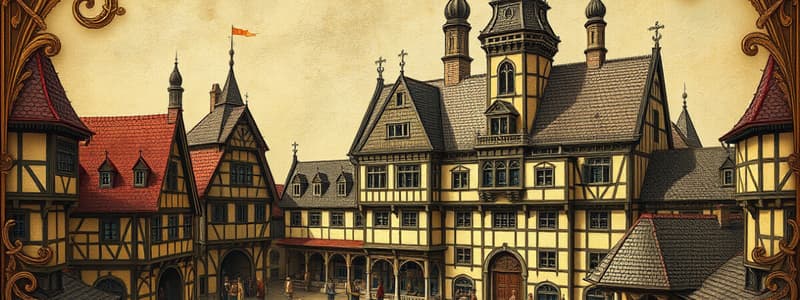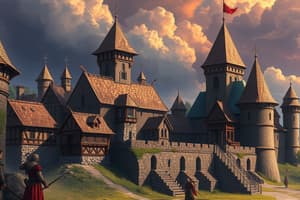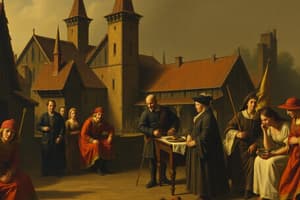Podcast
Questions and Answers
What prompted the establishment of feudalism in Europe around 1000 CE?
What prompted the establishment of feudalism in Europe around 1000 CE?
- The decline of the nobility's power
- An increase in population and crop yields (correct)
- The spread of democracy
- The formation of nation-states
What role did lords play in the feudal system?
What role did lords play in the feudal system?
- They provided land in exchange for military service (correct)
- They acted as knights serving other lords
- They were commoners who farmed the land
- They were kings who ruled over the land
Which term describes the land granted to a vassal by a king?
Which term describes the land granted to a vassal by a king?
- Vassalage
- Serfdom
- Duchy
- Fief (correct)
How did vassals contribute to the feudal system?
How did vassals contribute to the feudal system?
Who were the primary beneficiaries of the feudal structure?
Who were the primary beneficiaries of the feudal structure?
What were the promises sworn by vassals to their kings called?
What were the promises sworn by vassals to their kings called?
What characterized the political landscape during the rise of feudalism?
What characterized the political landscape during the rise of feudalism?
Which position in society directly served the king and fought in battles?
Which position in society directly served the king and fought in battles?
How did feudalism affect people's sense of identity?
How did feudalism affect people's sense of identity?
What is a characteristic of nobility within the feudal system?
What is a characteristic of nobility within the feudal system?
Flashcards are hidden until you start studying
Study Notes
Overview of Feudalism
- Emerged around 1000 CE during a period of population growth and increased life expectancy in Europe.
- Warmer climate led to enhanced crop yields and the establishment of new towns.
Structure of Feudalism
- Kings were the primary rulers controlling land and establishing social order.
- Lords and knights served as military support for kings, forming a hierarchy of loyalty and service.
- Nobility held significant power, as they occupied key positions and received land grants.
Key Components
- Vassalage: A system in which lords (vassals) pledged loyalty to kings in exchange for land (fiefs).
- Lords received fiefs—a sizable plot of land—from kings, enabling them to manage and govern smaller territories.
Dynamics of Loyalty
- The relationship was based on mutual promises: vassals vowed to defend the king, while kings promised protection and support for their vassals.
- Oaths of loyalty were vital in maintaining feudal ties and fostering a sense of community among vassals.
Absence of Central Governments
- During the Middle Ages, the concept of nations or modern central governments was not fully established.
- Governance was instead characterized by interconnected networks of lords and vassals operating under kings’ authority.
Vocabulary
- Lord: A powerful individual controlling land granted by a king.
- Knight: A mounted soldier who serves a king or lord.
- Nobility: Influential families holding land (fiefs) and titles.
- Feudalism: A governmental system where land is exchanged for loyalty and military service.
- Vassal: A party receiving land from a ruler and agreeing to provide military service.
- Fief: The land granted to a vassal in exchange for loyalty.
Studying That Suits You
Use AI to generate personalized quizzes and flashcards to suit your learning preferences.




